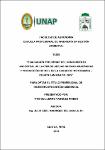| dc.contributor.advisor | Manrique del Águila, Julio Abel | |
| dc.contributor.author | Vasquez Pinedo, Tito Guillermo | |
| dc.date.accessioned | 2024-03-04T18:14:19Z | |
| dc.date.available | 2024-03-04T18:14:19Z | |
| dc.date.issued | 2023 | |
| dc.identifier.other | 638.16 V32 2023 | |
| dc.identifier.uri | https://hdl.handle.net/20.500.12737/9883 | |
| dc.description.abstract | In the city of Moyobamba located in the San Martín region, the present work is developed, the objective is to investigate the ancestral knowledge of the breeding of native Amazonian bees in the residents of the city of Moyobamba, in the natural environment. It is concluded that the people in the study have a high level of knowledge of the breeding of native bees in the natural environment, they know the meliponera species, nesting sites, honey harvest times, sex of the insects, natural feeding, and they recognize the sex , species of plants that serve as food and therefore maintain nearby forests by planting fruit trees, learned by direct observation the natural breeding of bees, being motivated in schools and higher institutes and by family tradition. They identify 31 to 40 colonies per year (40%) and 21 to 30 hives per year (20%), whether in secondary or primary forests (80%), and harvest honey from June to November (80%), using This is manual tools for extracting honey from the “nideras”, with times of one hour. One hive generates 2 Kg honey/hive, (4 bottles of 626 ml.). They check the hives before exploitation, if there are bees around, entry free of dead bees and wax, (non-sick swarm), presence of queen and larvae, there is honey production inside. They relate to temperature, humidity and rainfall, as factors that affect bee production, in addition to knowing that deforestation, use of agrochemicals, forest fires, can decrease bee populations. | en_US |
| dc.description.abstract | En la ciudad de Moyobamba ubicada en la región San Martín, se desarrolla el presente trabajo, del objetivo se desprende que es, indagar acerca del conocimiento ancestral de la cría de abejas nativas amazónicas en los pobladores de la ciudad de Moyobamba, en el medio natural. Se finiquita que las personas del estudio, poseen alto nivel de conocimiento de la cría de abejas nativas en el medio natural, conocen las especies meliponeras, sitios de anidación, tiempos de cosecha de miel, sexo de los insectos, alimentación natural, reconocen el sexo, especies de plantas que sirven de alimento y por ello mantienen bosques cercanos con la siembra de frutales, aprendieron por observación directa la cría natural de abejas, siendo motivados en colegios e institutos superiores y por tradición familiar. Identifican de 31 a 40 colonias por año (40%) y de 21 a 30 colmenas por año (20%), sean en bosques secundarios o primarios (80%), y cosechan miel desde junio hasta noviembre (80%), utilizando para ello herramientas manuales para la extracción de la miel de las “nideras”, con tiempos de una hora. Una colmena genera 2 Kg miel /colmena, (4 botellas de 626 ml.). Verifican las colmenas antes de su explotación, si existe abejas alrededor, entrada libre de abejas muertas y ceras, (enjambre no enfermo), presencia reina y larvas, existe producción de miel en el interior. Relacionan a la temperatura, humedad y precipitación pluvial, como factores que inciden en la producción apícola, además de saber que la deforestación, uso de agroquímicos, incendios forestales, pueden descender las poblaciones de abeja. | es_PE |
| dc.format | application/pdf | es_PE |
| dc.language.iso | spa | es_PE |
| dc.publisher | Universidad Nacional de la Amazonía Peruana | es_PE |
| dc.rights | info:eu-repo/semantics/openAccess | * |
| dc.rights.uri | https://creativecommons.org/licenses/by/4.0/ | * |
| dc.subject | Apicultura | es_PE |
| dc.subject | Conocimientos tradicionales | es_PE |
| dc.subject | Abeja sin aguijón | es_PE |
| dc.subject | Meliponal | es_PE |
| dc.subject | Producción de miel de abeja | es_PE |
| dc.subject | Polinización | es_PE |
| dc.title | Evaluación preliminar del conocimiento ancestral de la cría de abejas nativas amazónicas y producción de miel en la ciudad de Moyobamba – Región San Martín. 2022 | es_PE |
| dc.type | info:eu-repo/semantics/bachelorThesis | es_PE |
| thesis.degree.discipline | Ingeniería en Gestión Ambiental | es_PE |
| thesis.degree.grantor | Universidad Nacional de la Amazonía Peruana. Facultad de Agronomía | es_PE |
| thesis.degree.name | Ingeniero(a) en Gestión Ambiental | es_PE |
| dc.subject.ocde | https://purl.org/pe-repo/ocde/ford#4.02.01 | es_PE |
| renati.author.dni | 74821606 | |
| renati.advisor.orcid | https://orcid.org/0000-0001-5728-118X | |
| renati.advisor.dni | 5221163 | |
| renati.type | https://purl.org/pe-repo/renati/type#tesis | es_PE |
| renati.discipline | 521236 | es_PE |
| renati.level | https://purl.org/pe-repo/renati/level#tituloProfesional | es_PE |
| renati.juror | Chavez Vasquez, Rafael | |
| renati.juror | Yalta Vega, Ronald | |
| renati.juror | Pinedo Jimenez, Julio | |
| dc.publisher.country | PE | es_PE |





